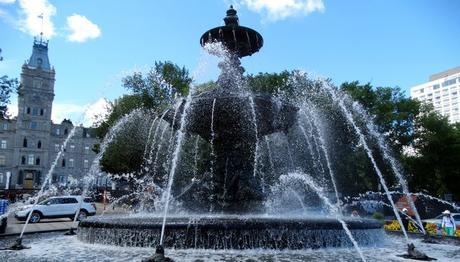 During a recent family stay in Québec City, Canada, I was able to witness a little piece of Bordeaux history which is now on permanent display outside the Québec province’s parliamentary building on Avenue Honoré-Mercier: the Fontaine de Tourny.
During a recent family stay in Québec City, Canada, I was able to witness a little piece of Bordeaux history which is now on permanent display outside the Québec province’s parliamentary building on Avenue Honoré-Mercier: the Fontaine de Tourny. The fountain has already featured on the blog, as part of the investigation into the Léon Gambetta monument which was the centrepiece of the Allées de Tourny throughout much of the 20th century. At the time, the Allées were bookended by two ornate fountains which were first installed there in 1857. Just like the Gambetta monument, the fountains were removed during the 1960s overhaul of the esplanade (the main aim of which was to install an underground car park). As their upkeep was considered too costly, the fountains would never return.
One of the fountains can now be found in Soulac-sur-Mer, to the north of Bordeaux. When I visited it during a tour of the town, the fountain appeared to be in poor condition and was not in operation. Meanwhile, its Québec City twin is in rude health and has become a major local attraction.
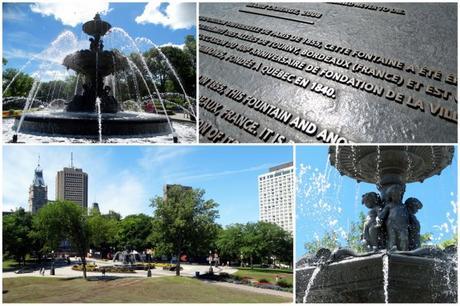
Further views of the fountain in front of the Québec province's parliamentary building, and part of the accompanying plaque.
The fountains were two of 15 identical 7-metre-tall, 4-metre-wide pieces designed by Mathurin Moreau in 1854, the layout of which was conceived by Michel Joseph Napoléon Liénard. Sculptures include four infants holding hands, and adult figures that depict the mythological gods Neptune, Acis, Amphitrite and Galatea. The fountains were produced by the Barbezat foundry in Val d’Osne (whose signature can also be spotted on many of the original-vintage Wallace fountains, including those in Bordeaux) and the design was awarded a gold medal at the Universal Exhibition held in Paris in 1855. That is where the then-mayor of Bordeaux, Alfred Daney, decided to purchase the pair, at a cost of 25,000 francs each, to mark the arrival of running water throughout the city.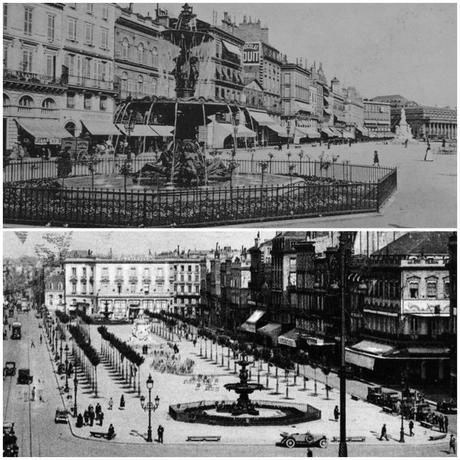
The Allées de Tourny as they looked when they were bookended by the two fountains. On both pictures, the Léon Gambetta monument can be spotted towards the middle of the esplanade.
Upon removal in the 1960s, the fountains were initially stored in municipal depots. The fountain bound for Soulac appears to have been installed there shortly afterwards. As regards the fountain which ended up in Québec, it was fully dismantled and reportedly sold on "by the kilo" to a wine château owner in Fronsac. It was put on display in the grounds of his château, although during this period the main figures at the base of the fountain were separated from the main structure (as pictured here on 33-bordeaux.com). In the 1990s, the fountain ended up in the hands of antiques dealer Marc Maison in Saint-Ouen just outside Paris.That is where the fountain - still in pieces and in very poor condition - was spotted and acquired in 2003 by Peter Simons, manager of the Québecois clothing outlet Simons. As well as its purchase, Simons financed its restoration (this all added up to 4 million Canadian dollars) and, in October 2004, Peter Simons announced that they would donate the fountain to Québec City to celebrate the city’s 400th anniversary while also underlining the company’s appreciation of the city and its people, who had contributed to Simons’ success since being founded in 1840.
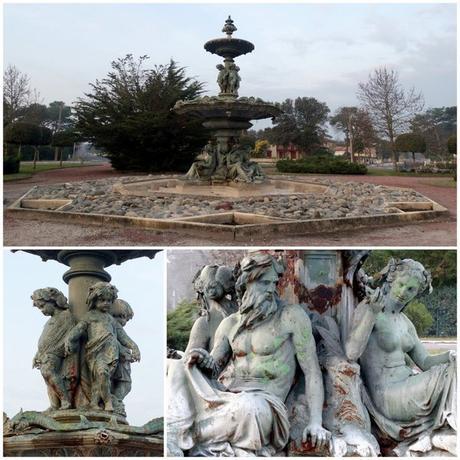
As reported in 2015, the twin fountain in Soulac-sur-Mer, isn't in such great shape.
The Québec fountain was officially inaugurated on July 3rd 2007, precisely one year ahead of the city’s 400th anniversary. Installation costs (estimated at 2 million Canadian dollars) were covered by the city authorities and the Commission de la capitale nationale du Québec. And judging by the time I spent monitoring the fountain during my stay in Québec City (which happens to be one of Bordeaux’s twin cities), it has indeed become an essential city sight, forming a backdrop for photos taken by loving couples, families and groups of travellers, at all times of day and night.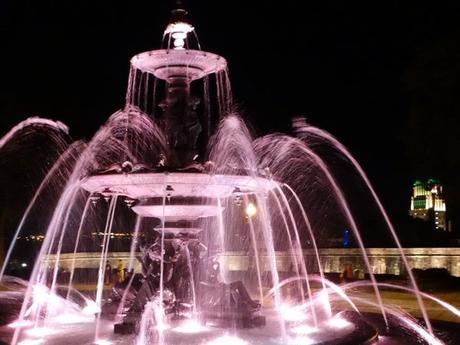
Québec's Fontaine de Tourny by night. The famous Édifice Price building is visible in the background.
Finally, other than the two Bordeaux fountains that have ended up in Soulac and Québec, others of the same Mathurin Moreau design can be found in Angers (in the Jardin du Mail), Geneva, Switzerland (in the Jardin Anglais) and Valencia, Spain (on Plaza Llano de Real). One can also be spotted in Launceston in Tasmania (Prince’s Square). A popular local myth suggests the fountain had initially been ordered by the town of Launceston in the UK but was mistakenly delivered to its Australian namesake in 1859. The potential cost of rectifying the error would have been too great, so the fountain stayed put in Tasmania!Enjoy this exclusive video visit of Québec City's Fontaine de Tourny:
Click here if video doesn't display properly on your device
